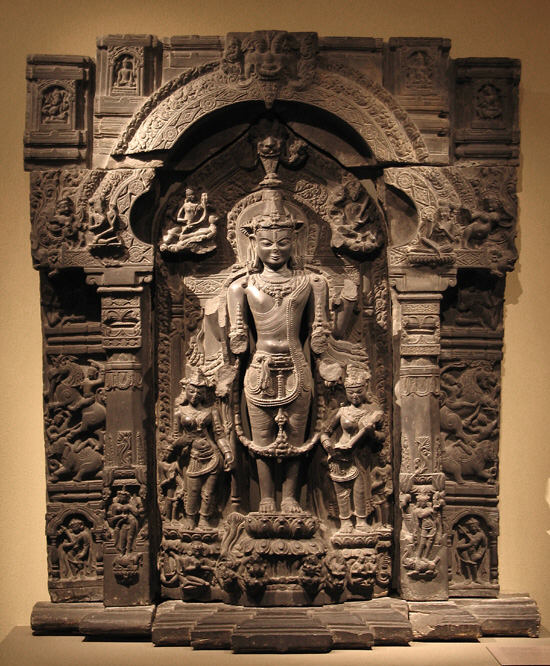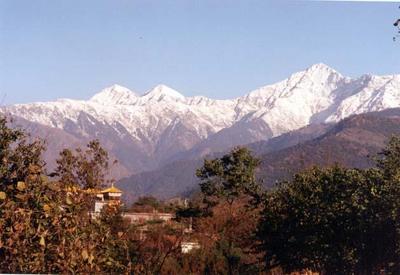|
Dharmapala (emperor)
Dharmapala (Siddhamātṛikā Script: , Dha-rmma-pā-la; Bangla: ধর্মপাল)(ruled between 770s-810s AD) was the second ruler of the Pala Empire of Bengal and Bihar regions in the Indian subcontinent. He was the son and successor of Gopala, the founder of the Pala Dynasty. He greatly expanded the boundaries of the empire, and made the Palas a dominant power in the northern and eastern India. Dharmapala directly ruled over the present-day Bengal and Bihar, and installed a nominee at Kannauj. The Pala chronicles also claim that several other rulers of North India acknowledged his suzerainty, but these claims seem to be exaggerated. Dharmapala was defeated twice by the Gurjara-Pratiharas, but each time the Rashtrakutas subsequently defeated the Pratiharas, leaving Palas as the dominant power in North India. Dharmapala was succeeded by his son Devapala who further expanded the empire. Reign Based on the different interpretations of the various epigraphs and historica ... [...More Info...] [...Related Items...] OR: [Wikipedia] [Google] [Baidu] |
Pala Empire
The Pāla Empire (r. 750-1161 CE) was an imperial power during the post-classical period in the Indian subcontinent, which originated in the region of Bengal. It is named after its ruling dynasty, whose rulers bore names ending with the suffix ''Pāla'' ("protector" in Prakrit). The empire was founded with the election of Gopāla as the emperor of Gauda in late eighth century AD. The Pala stronghold was located in Bengal and eastern Bihar, which included the major cities of Gauḍa, Vikramapura, Pāṭaliputra, Monghyr, Somapura, Ramavati (Varendra), Tāmralipta and Jaggadala. The Pālas were astute diplomats and military conquerors. Their army was noted for its vast war elephant corps. Their navy performed both mercantile and defensive roles in the Bay of Bengal. At its zenith under emperors Dharmapala and Devapala in the early ninth century, the Pala empire extended their dominance into the northern Indian region, with its territory stretching across the Gangetic pl ... [...More Info...] [...Related Items...] OR: [Wikipedia] [Google] [Baidu] |
Matsya Kingdom
Matsya ( sa, मत्स्य) was a Vedic kingdom and later became a part of sixteen Mahajanapadas, which also appears in Hindu Epic literature. The capital of Matsya was at Viratanagari (present-day Bairat, in Rajasthan) which is said to have been named after its founder king, Virata. Mention in Mahabharata Matsya kingdom was founded by king Matsya who was the twin brother of Satyavati and who was contemporary to Bhishma. The ''Mahabharata The ''Mahābhārata'' ( ; sa, महाभारतम्, ', ) is one of the two major Sanskrit epics of ancient India in Hinduism, the other being the ''Rāmāyaṇa''. It narrates the struggle between two groups of cousins in the Kuruk ...'' (V.74.16) refers to a King Sahaja, who ruled over both the Chedis and the Matsyas, which implies that Matsya once formed a part of the Chedi Kingdom. References Kingdoms in the Mahabharata {{Hindu-myth-stub ... [...More Info...] [...Related Items...] OR: [Wikipedia] [Google] [Baidu] |
Dhruva Dharavarsha
Dhruva (ruled 780–793 CE) was one of the most notable rulers of the Rashtrakuta Empire. He ascended the throne after replacing his elder brother Govinda II. Govinda II had become unpopular among his subjects on account of his various misconducts as a ruler, including excessive indulgence in sensual pleasures. This according to the historian Kamath is evident from the Karhad plates of Krishna III.Kamath (2001), p75 The Dhulia grant of 779 and Garugadahalli inscription of 782 proclaim Dhruva the emperor. Though some historians claim that Dhruva revolted and grabbed the throne,Reu (1933), p62 other historians feel the transition of the throne from Govinda II to Dhruva was peaceful and may have happened willingly. Dr. P. B. Desai and K. V. Subrahmanya Aiyar in Kamath (2001), p75 He earned titles like ''Kalivallabha'', ''Srivallabha'', ''Dharavarsha'', ''Maharajadhiraja'' and ''Parameshvara''. Success in north and east Dhruva Dharavarsha had a high political aspiration and he ac ... [...More Info...] [...Related Items...] OR: [Wikipedia] [Google] [Baidu] |
Allahabad
Allahabad (), officially known as Prayagraj, also known as Ilahabad, is a metropolis in the Indian state of Uttar Pradesh.The other five cities were: Agra, Kanpur (Cawnpore), Lucknow, Meerut, and Varanasi (Benares). It is the administrative headquarters of the Allahabad district—the most populous district in the state and 13th most populous district in India—and the Allahabad division. The city is the judicial capital of Uttar Pradesh with the Allahabad High Court being the highest judicial body in the state. As of 2011, Allahabad is the seventh most populous city in the state, thirteenth in Northern India and thirty-sixth in India, with an estimated population of 1.53 million in the city. In 2011 it was ranked the world's 40th fastest-growing city. Allahabad, in 2016, was also ranked the third most liveable urban agglomeration in the state (after Noida and Lucknow) and sixteenth in the country. Hindi is the most widely spoken language in the city. Allahabad l ... [...More Info...] [...Related Items...] OR: [Wikipedia] [Google] [Baidu] |
Vatsraja
Vatsaraja (780–800) or Vatsraja was an Emperor of the Gurjara-Pratihara dynasty in Northern India. He was grand-nephew of Nagabhata I and his mother was queen Bhuyikadevi. He was the first ruler of Rajasthan to win victories over the distant regions of Kanauj and Bengal. His extensive conquests mark the rise of the Imperial Gurjara-Pratiharas. Reign After Nagabhata I, he was succeeded by his nephews, there have been two rulers namely Kakkuka and Devaraja before Vatsraja came to the throne. Kakustha or Kakkuka was the nephew of Nagabhata I and nothing much is known about him. The younger brother of Kakkuka, king Devasakti or Devaraja is described as having curbed the freedom of a multitude of rulers. After bringing much of Rajasthan under his control, Vatsaraja then embarked to become "master of all the land lying between the two seas." Contemporary Jijasena's Harivamsha purana describes him as "master of western quarter" According to Radhanpur Plate Inscription and Prithvi ... [...More Info...] [...Related Items...] OR: [Wikipedia] [Google] [Baidu] |
Kangra Valley
Kangra Valley is a river valley situated in the Western Himalayas.Earthquakes '''', v. 1, ''p. 98.'' It lies in the state of in , and is a popular tourist destination. The is spoken there. |
Gandhara
Gandhāra is the name of an ancient region located in the northwestern region of the Indian subcontinent, more precisely in present-day north-west Pakistan and parts of south-east Afghanistan. The region centered around the Peshawar Valley and Swat river valley, though the cultural influence of "Greater Gandhara" extended across the Indus river to the Taxila region in Potohar Plateau and westwards into the Kabul Valley in Afghanistan, and northwards up to the Karakoram range. Gandhara has a deep rooted history of Hinduism mentioned in Indian scripts and epics including Rig Veda, Ramayana and Mahabharata. Famed for its unique Gandharan style of art which is influenced by the classical Hellenistic styles, Gandhara attained its height from the 1st century to the 5th century CE under the Kushan Empire, who had their capital at Peshawar (''Puruṣapura''). Gandhara "flourished at the crossroads of India, Central Asia, and the Middle East," connecting trade routes and absor ... [...More Info...] [...Related Items...] OR: [Wikipedia] [Google] [Baidu] |
Avanti (India)
Avanti ( sa, अवन्ति) was an ancient Indian Mahajanapada (''Great Realm''), roughly corresponding to the present-day Malwa region. According to the Buddhist texts, the ''Anguttara Nikaya'', Avanti was one of the ''solasa mahajanapadas'' (sixteen great realms) of the 6th century BCE. The ''janapada'' was divided into two parts by the Vindhyas, the northern part had its capital at Ujjayini and the southern part had its centre at Mahishmati. The Avantis, the ancient people belonging to this realm, were described as ''mahavala'' (very powerful) in the Udyoga Parva (19.24) of the Mahabharata.Law, B.C. (1973). ''Tribes in Ancient India'', Bhandarkar Oriental Series No.4, Poona: Bhandarkar Oriental Research Institute, pp.337-43 According to the Vishnu Purana (II.3), the Bhagavata Purana (XII.I.36) and the Brahma Purana (XIX.17), the Avantis were associated with the Malava, the Saurashtras, the Abhiras/Yadavas, the Suras, the Karushas and the Arbudas and were described as ... [...More Info...] [...Related Items...] OR: [Wikipedia] [Google] [Baidu] |
Yavana
The word Yona in Pali and the Prakrits, and the analogue Yavana in Sanskrit and Yavanar in Tamil, were words used in Ancient India to designate Greek speakers. "Yona" and "Yavana" are transliterations of the Greek word for "Ionians" ( grc, Ἴωνες < Ἰάoνες < *Ἰάϝoνες), who were probably the first Greeks to be known in the East. Both terms appear in ancient literature. ''Yavana'' appears, for instance, in the '''', while ''Yona'' appears in texts such as the n chronicle '' Mahavamsa''. The Yona are mentioned in ... [...More Info...] [...Related Items...] OR: [Wikipedia] [Google] [Baidu] |
Katas Raj Temples
The Shri Katas Raj Temples ( Punjabi, ur, ) (Sanskrit: कटासराज) also known as Qila Katas (), is a complex of several Hindu temples connected to one another by walkways. The temple complex surrounds a pond named ''Katas'' which is regarded as sacred by Hindus. The complex is located in the Potohar Plateau region of Pakistan's Punjab province. The temples are located in municipal committee Choa Saidanshah, and are near the M2 Motorway. The temples' pond is said in the ''Puranas'' to have been created from the teardrops of Shiva, after he wandered the Earth inconsolable after the death of his wife Sati. The pond occupies an area of two kanals and 15 marlas, with a maximum depth of 20 feet. The temples play a role in the Hindu epic poem, the ''Mahābhārata'', where the temples are traditionally believed to have been the site where the ''Pandava'' brothers spent a significant portion of their exile. It is also traditionally believed by Hindus to be the site where th ... [...More Info...] [...Related Items...] OR: [Wikipedia] [Google] [Baidu] |
Dwarka
Dwarka () is a city and a municipality of Devbhumi Dwarka district in the state of Gujarat in Western India. It is located on the western shore of the Okhamandal Peninsula on the right bank of the Gomti river at the mouth of the Gulf of Kutch facing the Arabian Sea. Often identified with the Dwarka Kingdom, described in the ''Bhagavata Purana'' as the ancient kingdom of Krishna and is believed to have been the first capital of Gujarat. Dwarka has the Dwarkadhish Temple dedicated to Krishna, which is one of four sacred Hindu pilgrimage sites collectively called the Chardham, which were founded by Adi Shankaracharya (686–717 AD) at the four corners of the country, was established as a monastic center and it forms part of the Dwarka temple complex. Dwarka is also one of the seven-most-ancient religious cities (Sapta Puri) in India. Dwarka is part of the "Krishna pilgrimage circuit" which includes Vrindavan, Mathura, Barsana, Gokul, Govardhan, Kurukshetra and Puri ... [...More Info...] [...Related Items...] OR: [Wikipedia] [Google] [Baidu] |
Mathura
Mathura () is a city and the administrative headquarters of Mathura district in the Indian state of Uttar Pradesh. It is located approximately north of Agra, and south-east of Delhi; about from the town of Vrindavan, and from Govardhan. In ancient times, Mathura was an economic hub, located at the junction of important caravan routes. The 2011 Census of India estimated the population of Mathura at 441,894. In Hinduism, Mathura is birthplace of Krishna, which is located at the Krishna Janmasthan Temple Complex. It is one of the Sapta Puri, the seven cities considered holy by Hindus, also called Mokshyadayni Tirth. The Kesava Deo Temple was built in ancient times on the site of Krishna's birthplace (an underground prison). Mathura was the capital of the kingdom of Surasena, ruled by Kansa, the maternal uncle of Krishna. Mathura is part of the Lord Krishna circuit (Mathura,Vrindavan, Barsana, Govardhan, Kurukshetra, Dwarka and Bhalka). Janmashtami is grandly celebrate ... [...More Info...] [...Related Items...] OR: [Wikipedia] [Google] [Baidu] |





.jpg)



